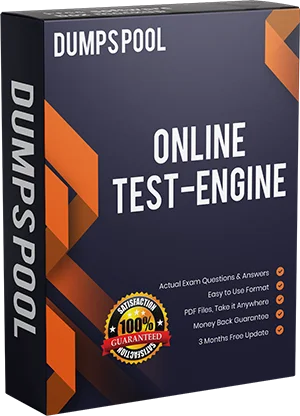PDF Only

$750.00 Free Updates Upto 90 Days
- CPHQ Dumps PDF
- 140 Questions
- Updated On July 26, 2024
PDF + Test Engine

$1,150.00 Free Updates Upto 90 Days
- CPHQ Question Answers
- 140 Questions
- Updated On July 26, 2024
Test Engine

$950.00 Free Updates Upto 90 Days
- CPHQ Practice Questions
- 140 Questions
- Updated On July 26, 2024
How to pass NAHQ CPHQ exam with the help of dumps?
DumpsPool provides you the finest quality resources you’ve been looking for to no avail. So, it's due time you stop stressing and get ready for the exam. Our Online Test Engine provides you with the guidance you need to pass the certification exam. We guarantee top-grade results because we know we’ve covered each topic in a precise and understandable manner. Our expert team prepared the latest NAHQ CPHQ Dumps to satisfy your need for training. Plus, they are in two different formats: Dumps PDF and Online Test Engine.
How Do I Know NAHQ CPHQ Dumps are Worth it?
Did we mention our latest CPHQ Dumps PDF is also available as Online Test Engine? And that’s just the point where things start to take root. Of all the amazing features you are offered here at DumpsPool, the money-back guarantee has to be the best one. Now that you know you don’t have to worry about the payments. Let us explore all other reasons you would want to buy from us. Other than affordable Real Exam Dumps, you are offered three-month free updates.
You can easily scroll through our large catalog of certification exams. And, pick any exam to start your training. That’s right, DumpsPool isn’t limited to just NAHQ Exams. We trust our customers need the support of an authentic and reliable resource. So, we made sure there is never any outdated content in our study resources. Our expert team makes sure everything is up to the mark by keeping an eye on every single update. Our main concern and focus are that you understand the real exam format. So, you can pass the exam in an easier way!
IT Students Are Using our Certified Professional in Healthcare Quality Examination Dumps Worldwide!
It is a well-established fact that certification exams can’t be conquered without some help from experts. The point of using Certified Professional in Healthcare Quality Examination Practice Question Answers is exactly that. You are constantly surrounded by IT experts who’ve been through you are about to and know better. The 24/7 customer service of DumpsPool ensures you are in touch with these experts whenever needed. Our 100% success rate and validity around the world, make us the most trusted resource candidates use. The updated Dumps PDF helps you pass the exam on the first attempt. And, with the money-back guarantee, you feel safe buying from us. You can claim your return on not passing the exam.
How to Get CPHQ Real Exam Dumps?
Getting access to the real exam dumps is as easy as pressing a button, literally! There are various resources available online, but the majority of them sell scams or copied content. So, if you are going to attempt the CPHQ exam, you need to be sure you are buying the right kind of Dumps. All the Dumps PDF available on DumpsPool are as unique and the latest as they can be. Plus, our Practice Question Answers are tested and approved by professionals. Making it the top authentic resource available on the internet. Our expert has made sure the Online Test Engine is free from outdated & fake content, repeated questions, and false plus indefinite information, etc. We make every penny count, and you leave our platform fully satisfied!
Frequently Asked Questions
Question # 1
In managed care, the most widely used performance measures are
A. Agency for Healthcare Research and Quality (AHRQ).
B. Healthcare Effectiveness Data and Information Set (HEDIS).
C. National Quality Forum (NQF).
D. Uniform Hospital Discharge Data Set (UHDDS).
Question # 2
Which of the following charts would most likely be used first in a root cause analysis?
A. Pareto
B. control
C. flow
D. Gantt
Question # 3
The perception of how an organization operates, including how employees relate to internal and external customers, is the organizational
A. mission.
B. vision.
C. structure.
D. culture.
Question # 4
The leader of a pain management performance improvement team has asked the Quality Council to disband the team. The most important factor for the Quality Council to assess is
A. the amount of data the team has collected.
B. the effectiveness of the team leader and facilitator.
C. how well the team met the intended outcome.
D. the length of time the team has been together.
Question # 5
When considering the use of an external subject matter expert (SME), which of the following characteristics is most critical?
A. references of the SME
B. cost of the SME's services
C. geographic location of the SME
D. leadership's personal preference
Question # 6
A consulting firm has been selected by a facility's quality professional to assess the quality improvement program. Before starting the assessment, the quality professional should
A. define expectations and outcomes.
B. develop potential action plans.
C. help the consulting firm to identify problem areas.
D. schedule the activities of the consulting firm.
Question # 7
Performing a root cause analysis of a sentinel/unexpected event provides all of the following EXCEPT
A. recommendation for actions to prevent or decrease recurrence.
B. measurement strategies for each factor affecting the outcome.
C. continuous monitoring to identify opportunities for improvement.
D. identification of why the variance occurred.
Question # 8
The best way to evaluate the effectiveness of performance improvement training is through
A. observed behavioral changes.
B. participants' feedback.
C. post-test results.
D. self-assessments.
Question # 9
When examining the relationship between staff and patient outcomes, which of the following would be most appropriate to assess?
A. occurrence reports and sentinel events
B. staff turnover and budget
C. overtime data and absenteeism rates
D. patient safety data and overtime data
Question # 10
A new quality director has reviewed the information related to the Quality Council minutes and notes the following: - The council meets quarterly. Meetings last approximately two hours. - The council roster includes all clinical department managers and the quality director. Attendance ranges from 45-60%. -The primary role of the council is to receive department quality reports, which are then forwarded to the organization's governing body. Based on the information above, which of the following actions is most appropriate
A. Redefine the council's role to coordinate and prioritize quality activities.
B. Require departments to forward reports for review prior to the meetings.
C. Eliminate the council and directly report quality data to the governing body.
D. Switch to a monthly meeting with a new agenda format
Question # 11
A patient safety program can best be enhanced by which of the following technologies?
A. online evidence-based medicine guidelines
B. computers on wheels at the patients' bedsides
C. digital medication reference materials
D. barcode system for medication administration
Question # 12
Which of the following actions would have the greatest impact in reducing harm?
A. increasing data collection frequency
B. forming a performance improvement team
C. improving interdisciplinary communication
D. revising the patient safety evaluation tool
Question # 13
Which of the following is the major responsibility of senior management regarding continuous quality improvement?
A. Communicate the organizational mission and values.
B. Develop organization-wide training sessions.
C. Participate in Quality Council activities.
D. Conduct periodic reviews of the program.
Question # 14
In the quality improvement process, performing a cost-benefit analysis would be most useful in
A. designing solutions and controls.
B. checking performance.
C. analyzing process problems.
D. implementing solutions and controls.
Question # 15
Which of the following is always true regarding a sentinel event?
A. The findings must be reported to a regulatory body.
B. The occurrence requires an immediate investigative response.
C. The cause is established as a deviation from standards.
D. The incident is a result of a medical error.
Question # 16
A. Suspend privileges for physician C.
B. Initiate peer review with physician C.
C. Initiate peer review with physician A.
D. Suspend privileges for physician A.
Question # 17
Which of the following is the most effective way to integrate performance improvement concepts throughout an organization?
A. quality teams
B. monthly lectures
C. continuous monitoring
D. quarterly newsletters
Question # 18
A clinical pathway on the management of hip fractures has been developed by a multidisciplinary team and implemented in a large teaching hospital. After monitoring for 6 months, the length of stay continues to exceed the guidelines. Which of the following should be the next step?
A. Correlate the pathway with staffing levels.
B. Re-educate the staff on the purpose of the pathway.
C. Evaluate compliance with the pathway.
D. Continue to monitor and collect additional data.
Question # 19
Results of physician practice pattern studies are most likely to promote behavior changes when disseminated to the
A. practitioners.
B. governing body.
C. quality committee.
D. administration.
Question # 20
Random screening of newborns by the neonatology department has confirmed a high incidence of glucose insufficiency (G6PD) in the local population. Management believes that the cost of testing all newborns would be too high. Which of the following should the healthcare quality professional suggest?
A. Review literature to determine best practices.
B. Continue to conduct random testing.
C. Conduct an analysis to confirm management's beliefs.
D. Test only newborns with a family history of G6PD.
Question # 21
Which of the following topics are discussed at a morbidity and mortality conference?
A. planned readmissions and newborn mortality rates
B. healthcare-acquired infections and perioperative mortality
C. inpatient mortality and admissions
D. Cesarean section rates and number of physicians
Question # 22
A healthcare quality professional is conducting a study to determine how many patients contractedinfluenza after receiving flu shots. This study is evaluating
A. prevalence.
B. efficacy.
C. process.
D. appropriateness.
Question # 23
Which of the following should be included in an annual performance improvement report to a governing body?
A. team achievements
B. meeting minutes
C. incident/occurrence reports
D. physician peer reviews
Question # 24
A. caring and most satisfied with cost.
B. cost and most satisfied with caring.
C. communication and most satisfied with comfort.
D. cost and most satisfied with communication.
Question # 25
A summary of antibiotic usage for the fourth quarter showed that an internal medicine department did not meet pre-established criteria in 82% of the patients reviewed. Following review, the pharmacy and therapeutics committee should recommend that the results be shared first with the
A. utilization committee.
B. Quality Council.
C. governing body.
D. chief of the department
Question # 26
Frequency distribution can best be displayed through use of
A. an interrelationship diagram.
B. a force field analysis.
C. a flow chart.
D. a histogram.
Question # 27
In lean thinking, a process step is defined as "value added" if the
A. customer recognizes the value.
B. process owner recognizes the value.
C. process owner changes the value of the product.
D. customer corrects a mistake to add value.
Question # 28
A physician who has a high inpatient mortality rate compared to others in a facility should first be
A. suspended in the interest of patient safety.
B. counseled by the department chairperson.
C. evaluated by the credentialing committee.
D. subjected to a more in-depth review of cases.
Leave a comment
Your email address will not be published. Required fields are marked *